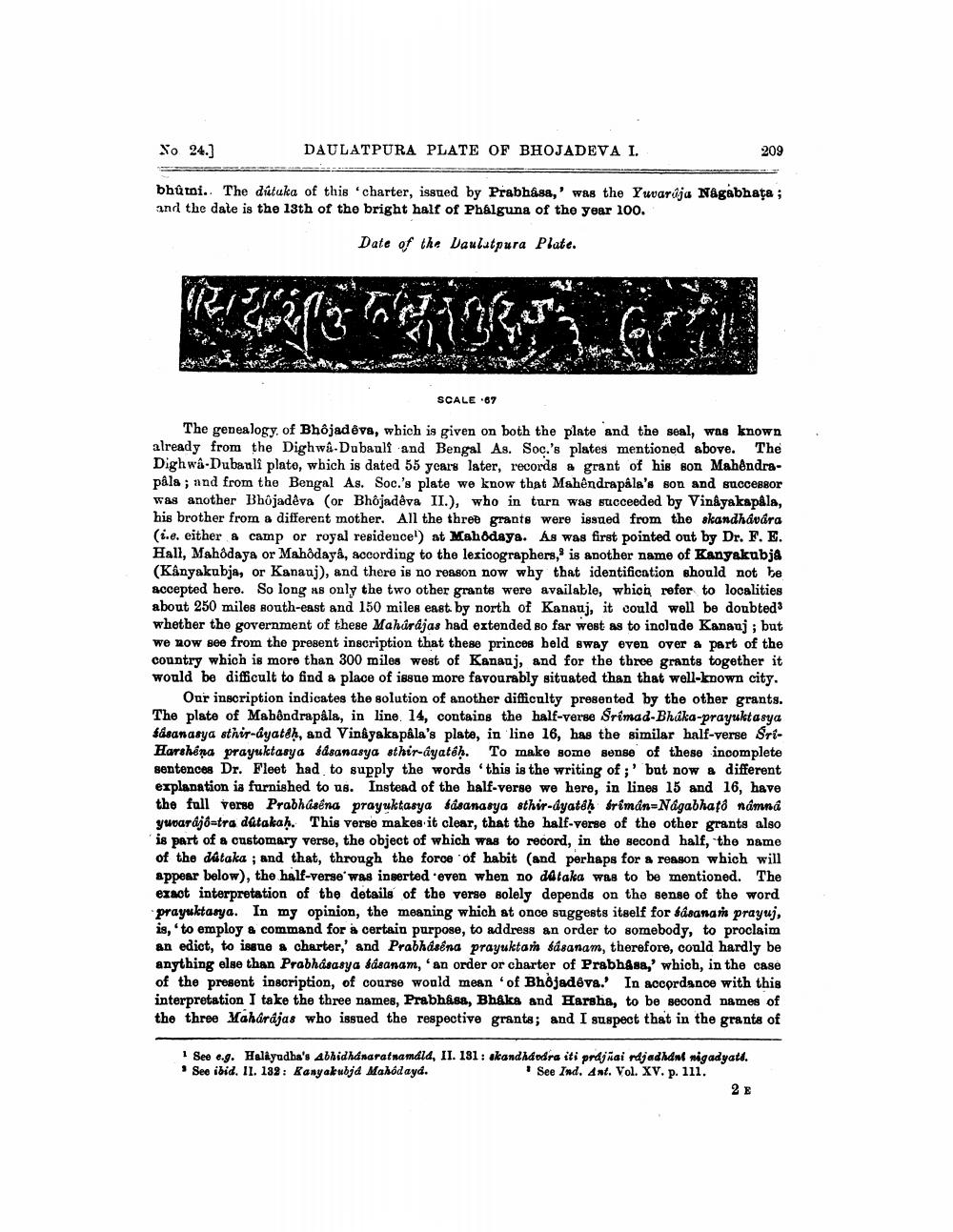________________
Xo 24.]
DAULATPURA PLATE OF BHOJADEVA I.
209
bhùti. The dituka of this charter, issued by Prabhasa,' was the Yuvarúja Nagabhata ; and the date is the 13th of the bright half of Phálguna of the year 100.
Date of the Daulatpura Plate.
WRZO
SCALE 67
The genealogy of Bhôjad êva, which is given on both the plate and the seal, was known already from the Dighwa-Dabauli and Bengal As. Soc.'s plates mentioned above. The Dighwa-Dubaali plate, which is dated 55 years later, records & grant of his son Mahendrapala ; and from the Bengal As. Soc.'s plate we know that Mahendrapala's son and successor was another Bhôjadeva (or Bhöjadeva II.), who in turn was succeeded by Vinayakapala, his brother from a different mother. All the three grants were issued from the skandhavára (i.e. either a camp or royal residence') at Mahôdaya. As was first pointed out by Dr. F. E. Hall, Mahôdaya or Mahôdaya, according to the lexicographers, is another name of Kanyakubja (Kanyakubja, or Kananj), and there is no reason now why that identification should not be accepted here. So long as only the two other grants were available, which refer to localities about 250 miles south-east and 150 miles east by north of Kanauj, it could well be doubted: whether the government of these Mahúrájas had extended so far west as to include Kananj; but we now see from the present inscription that these princes beld sway even over a part of the country which is more than 300 miles west of Kananj, and for the three grants together it would be difficult to find a place of issue more favourably situated than that well-known city.
Our inscription indicates the solution of another difficulty presented by the other grants. The plate of Mabôndrapala, in line. 14, contains the half-verse Srimad Bhaka-prayuktasya fásanasya sthir-ayatéh, and Vinayakapala's plate, in line 16, has the similar half-verse SriHarshéna prayuktasya säsanasya sthir-ayatéh. To make some sense of these incomplete sentencea Dr. Fleet had to supply the words this is the writing of ;' but now a different explanation is furnished to us. Instead of the half-verse we here, in lines 15 and 16, have the full verse Prabhasena prayuktasya fasanasya sthir-dyatéh sriman Nagabható namna yuvarajó=tra datakaḥ. This verse makes it clear, that the half-verse of the other grants also is part of a customary verse, the object of which was to record, in the second half, the name of the dataka ; and that, through the force of habit (and perhaps for a reason which will appear below), the half-verse was inserted even when no dataka was to be mentioned. The exact interpretation of the details of the verse solely depends on the sense of the word prayuktasya. In my opinion, the meaning which at once suggests itself for fãsanan prayuj, is,'to employ a command for a certain purpose, to address an order to somebody, to proclaim an edict, to issue a charter,' and Prabhásêna prayuktan sàsanam, therefore, could hardly be anything else than Prabhasasya sasanam,' an order or charter of Prabhasa,' which, in the case of the present inscription, of course would mean of Bhojadeva. In accordance with this interpretation I take the three names, Prabhasa, Bhåks and Harsha, to be second names of the three Maharajas who issued the respective grants; and I suspect that in the grants of
1 See e.g. Helayudha's Abhidhanaratnamáld, II. 181: skandhandra iti prajnai rdjadhdnf migadyatd. See ibid. II. 182: Kanyakubjd Mahodaya.
See Ind. Ant. Vol. XV. p. 111.
2 E




